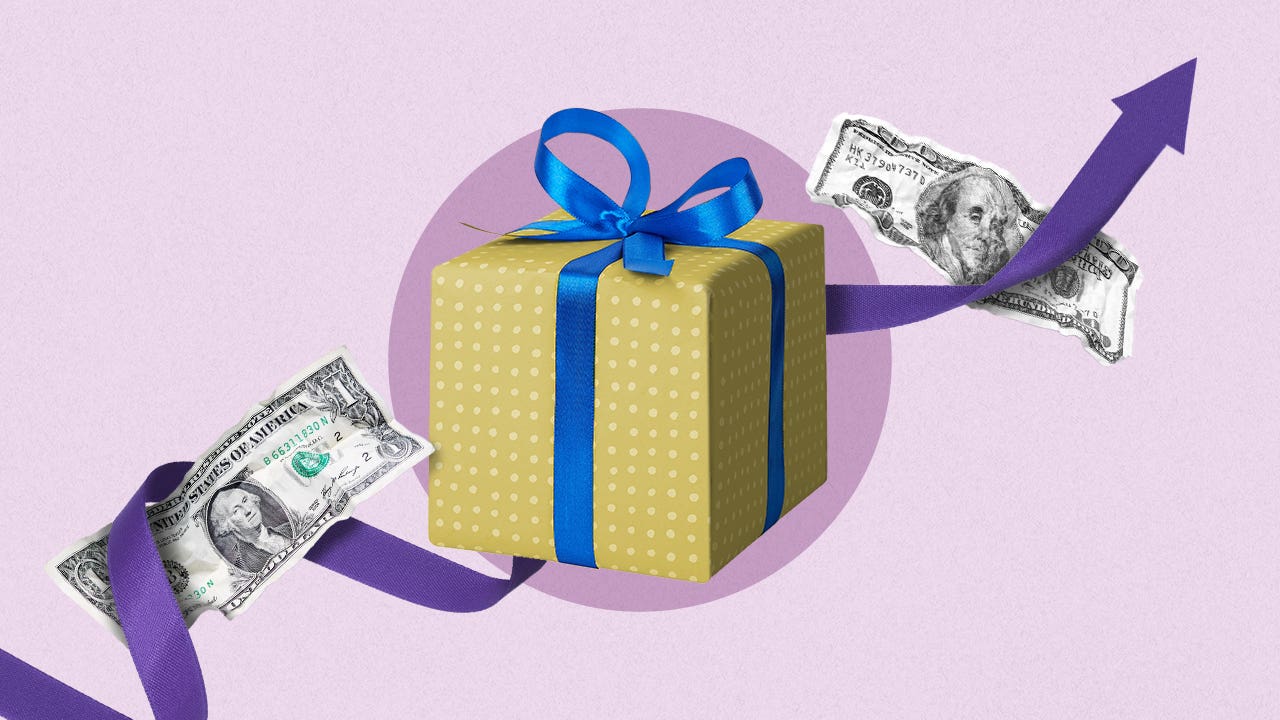Inflation is slowing on these holiday essentials, but prices are still up 21% since before the pandemic

The Bankrate promise
At Bankrate we strive to help you make smarter financial decisions. While we adhere to strict , this post may contain references to products from our partners. Here's an explanation for .
During this year’s holiday season, inflation isn’t nearly as much of a grinch as it was in 2022.
About two-thirds (or 65 percent) of holiday staples have gotten more expensive since November 2022, according to Bankrate’s annual analysis of the 40 items common to the season within the Bureau of Labor Statistics’ consumer price index (CPI). That’s down from almost 9 in 10 items (or 88 percent) in last year’s analysis, when just 12 percent were cheaper than they were in November 2021.
That slowdown is even better than it looks. Just two of the 40 holiday staples in Bankrate’s analysis rose by a double-digit pace over the past year, compared with last year’s 14 items that surged by 10 percent or more.
But that’s not to say consumers won’t still feel a bit of a pinch. The majority (90 percent) of holiday staples are more expensive today than they were in February 2020, before supply shocks and massive post-pandemic demand combined to push up prices on the items Americans both want and need faster than many have ever seen.
Higher post-pandemic prices might not be as concerning to economists, who pay closer attention to annual inflation rates for a more real-time look at price pressures. But consumers’ memories of how much it used to cost to fill up their gas tanks or buy a gallon of milk are causing them to be more downtrodden than they were at periods in the 1970s and ’80s. Over half (54 percent) of holiday shoppers expected to feel financially burdened this year, according to a Bankrate poll published in September. A third (33 percent) noted that inflation would likely impact their holiday shopping habits.
A combined look at those 40 essentials shows holiday inflation is up 21 percent since February 2020, according to Bankrate calculations using Bureau of Labor Statistics data. That estimate suggests it costs $121 to buy the same goods and services for the holidays that households would have been able to afford with $100 before the pandemic. Some consumers may even end up getting an even worse bang for their buck if they live in a high cost-of-living area.
Lower inflation doesn't mean deflation; it just means prices are still growing, albeit at a slower rate. For a while now, there’s been this light at the end of the tunnel — that at some point, inflation is going to be over and go back to normal. But unfortunately, that’s not how it works.— Ted Rossman | Bankrate senior analyst
Limiting how much inflation spoils your festivities comes down to knowing which items are most inflated and crafting a plan — for both your shopping and your budget. Here’s what could weigh on your holiday budget the most this year and how you can stretch your money.
Most expensive this year: Holiday entertaining and experiences
Bankrate separated those 40 holiday essentials into four categories: gifts, experiences, travel and entertaining. The analysis showed that inflation has slowed from last year in every category — as well as on a large majority of items (88 percent).
In Bankrate’s 2022 analysis, 83 percent of holiday essentials rose at an annual pace faster than the Fed’s general 2 percent goalpost. That share has fallen by more than half since then, with just 40 percent of the items in Bankrate’s holiday inflation analysis rising at a pace faster than 2 percent. About 18 percent of items didn’t even grow by more than a percent from last year.
Echoing trends from last year’s analysis, five of the top 10 most inflated items this year belonged to the entertaining category, four of which were food. At the top were sugar and sweets (5.4 percent), turkey (5 percent), bakery products (4.1 percent) and meats (3.6 percent). Two of those items — turkey and bakery products — made the top 10 list for the second year in a row.
But Americans aren’t seeing their grocery bills rise as quickly this year. Among the most inflated food items between November 2021 and November 2022 were flour and prepared mixes (24.6 percent), turkey (17.9 percent), dairy (16.4 percent) and bakery products (16.3 percent).
Eggs — the single most inflated item in last year’s analysis — soared 49.1 percent during last year’s holiday season. But they’ve since taken back about half of that increase, now costing 22.3 percent less than they did a year ago as of November.
A major help for Americans hoping to host holiday parties this year: Even utility costs aren’t rising as quickly. Energy services are up just 0.02 percent after a 14.3 percent burst last year. Meanwhile, housekeeping supplies are up 3.1 percent since November 2022. Household equipment and furnishings — which include those coveted Christmas trees and decorations of the season — are about 2 percent cheaper.
Top 10 most inflated holiday essentials in 2023
| Holiday essential | November 2022-November 2023 | November 2021-November 2022 | Category |
|---|---|---|---|
| *Denotes item that isn’t adjusted seasonally Source: Bureau of Labor Statistics, November CPI report |
|||
| Sporting event tickets* | +16.4% | -7.2% | Experiences |
| Transportation services | +10.1% | +14.3% | Travel |
| Photographers and photographic services* | +5.9% | +4.4% | Entertaining |
| Sugar and sweets | +5.4% | +13.1% | Entertaining |
| Alcoholic beverages away from home | +5.2% | +7.1% | Entertaining |
| Turkey | +5% | +17.9% | Entertaining |
| Movies, concerts and theater tickets | +4.4% | +7.4% | Experiences |
| Full service meals and snacks | +4.4% | +9% | Experiences |
| Bakery products | +4.1% | +16.3% | Entertaining |
| Meats | +3.6% | +1.1% | Entertaining |
Improving supply chains and discounts at retailers are helping make gifts among the least inflated items in Bankrate’s analysis. Of the 35 percent of items that are cheaper this year than a year ago, half belong to the gift-giving category.
Televisions are 9.5 percent cheaper from a year ago, while smartphones are down a whopping 14 percent since November 2022. Computers and smart home assistance devices (down 4.6 percent), toys, games, hobbies and playground equipment (4 percent), appliances (down 3.5 percent) and sporting goods (down 1.8 percent) also joined the ranks of gifts that are cheaper this year than last year.
Better deals on gifts are to be found — unless you’re thinking about gifting someone an experience this holiday season. Four of the 10 most inflated items belonged to the experiences category, with admissions to sporting events up 16.4 percent from a year ago — the single most inflated item this holiday season, according to Bankrate’s analysis. Concerts, movies and theater tickets are significantly less inflated, though still rising 4.4 percent from a year ago.
Meals out at restaurants are up 4.4 percent, while the price of having an alcoholic beverage at a bar or restaurant is up 5.2 percent from a year ago.
And with gas prices slowing and airline prices falling, just one item from the travel category made it to the top 10 list in 2023: Transportation services, which have risen 10.1 percent from a year ago.
Compared to before the pandemic, prices are still expensive
But even if inflation slowed on most items from last year, price pressures may still feel like they’re compounding. The jump in transportation services, for example, comes after a 14.3 percent increase in 2022 — making the price of key services like Lyft or Uber 25.3 percent more expensive today than they were before the pandemic. Meanwhile, even though turkey prices today are up a smaller 5 percent from a year ago, they’ve still soared 36.4 percent from pre-pandemic era prices.
Just four of the 40 items in Bankrate’s analysis are cheaper today than they were in February 2020:
- computers and smart home assistance devices (down 5.2 percent);
- airline fares (6.8 percent cheaper);
- televisions (down 21.5 percent); and
- smartphones (52.3 percent cheaper).
6 cost-saving strategies to handle inflation during the holidays
Not only is sticking to a budget harder today than it may have been three years ago, but it’s all the more imperative, too. Credit card financing rates have hovered at the highest levels ever recorded since last fall, most recently topping 20.72 percent, according to Bankrate data.
Even beyond holiday essentials, lingering inflation on the items core to consumers’ budgets — from groceries and rent to insurance and meals out — could eat away at the funds they have to spend this season.
The holidays might be the time of year when many consumers spend most. Americans spent $12.4 billion on Cyber Monday alone, and between Nov. 1-27, deal-hunting shoppers dished out a whopping $109.3 billion, data from Adobe Analytics shows.
Tracking holiday inflation might not be a good way of gauging overall trends surrounding price pressures. Individual items can rise and fall because of supply and demand. And ’tis the season for some prices — whether it’s a Christmas tree or gift wrap — to rise faster than others.
Instead, paying attention to inflation rates can help consumers learn how to score the best deal. But inflation — or rather, the lack thereof — should never be the sole reason you buy something this holiday season. Just as important to your budget as price-checking is making sure the item you’re buying is one worth spending money on.
“The difficulty is, these holiday events are really meaningful for people, and as important as it is to save money and to live within our means, it’s really important we have these connecting moments,” says Nate Astle, certified financial therapist and consultant for Beyond Finance. “You can have connecting moments without breaking the bank.”
Retailers and big-box chains are throwing out all the stops to woo holiday shoppers this year. Adobe’s analysis also showed that promotions and discounts hit record highs, with consumers finding deals in categories from electronics and appliances to apparel and toys.
Here’s how to craft a holiday budget and stick with it, whether you’re shopping for someone, throwing a party or planning a trip.
1. Craft your holiday budget, and don’t go over it
Before starting your holiday shopping, it’s a wise idea to know how much you can afford to spend. Take a look at your finances and figure out what your “hard stop” holiday number is — that is, the number you realistically can’t afford to go over. If you have a holiday fund already established, even better. Your spending shouldn’t be so high that you have to rely on credit card financing to purchase it, experts warn.
If you haven’t already built up a holiday savings fund, consider eliminating some discretionary purchases to free up cash. Don’t forget to keep track of your credit card rewards points when coming up with guardrails for your spending.
2. Ask who you’re shopping for to send you a list
It might seem like a sure way to ruin the surprise, but experts say you shouldn’t be the one making a list for your loved ones this holiday season. Instead, it should be the other way around.
Doing so not only gives consumers the opportunity to comparison shop, price check and look for items that clearly fit into their budgets — but it also helps make sure the gift you’re buying won’t go to waste. As inflation weighs on Americans’ wallets, no one wants to buy someone an unwanted item that just sits around and collects dust.
“Normalize gift giving as something that’s meant to be a shared experience, rather than something where you’re trying to hide the amount or hoping or wondering whether someone is going to like it,” Michael Liersch, head of advice and planning for Wells Fargo.
If you don’t manage to snag anyone’s holiday wish list, be sure the item you’re buying can be returned without a fee. Cash or gifts are also growing in popularity as gifts this year, with experts saying they’re a way to help show someone you care about them while sticking to your budget.
3. Compare individual inflation rates with the items you’re buying, but make sure they’re still useful
When consumers check out inflation rates on individual items, they can figure out where there are better deals. Alcoholic beverages at home, for example, are up 1.5 percent from a year ago — but they cost 5.2 percent more at a restaurant.
“The gift receiver need not know that the buyer got a good deal,” says Mark Hamrick, Bankrate senior economic analyst.
But wasting money can be even more detrimental to your budget than inflation. Consider the longevity of an item and whether it’s right for the individual.
It might be more expensive to go to a basketball game this year, sure, but if your significant other likes them more than musicals, that might not be the right way of putting your budget to use. Meanwhile, electronics may have fallen in price, but they’re still going to be a costlier purchase than say, a pair of jeans or a sweater — even if apparel is up 1.2 percent from a year ago.
“It’s this idea of, ‘If I buy something new, I’m going to really focus on the quality of that item and ensure it’s something I’m going to use, rather than accumulating a lot of things,” Liersch says. “Less is more and quality trumps quantity.”
Similarly, an item on sale might not always be the best deal. Be sure to price check every item you’re interested in buying. Even a simple Google search can do.
4. Travel tips: Don’t forget about your unused points and miles to fund your holiday travel
Consumers are often sitting on a stockpile of credit card rewards — “free” money that can only be put to use if it is, in fact, used. After you’ve price-checked flights or found the best mode of transportation to where you’ll be celebrating the holidays, be sure to utilize any credit card rewards points to fund some of that travel.
The right travel credit card could just be your saving grace in a high-inflationary environment. Not only could they offer you savings on flights, but many options on the market cover checked bags or travel insurance that can also help you save on any additional costs, such as delays or cancellations.
5. Find unique ways to give gifts or host gatherings this season
Americans hoping to limit the impact high prices have on their holiday budgets may want to embrace the unconventional.
Still want to throw a holiday party? Host a potluck so no one person has to take on the cost burden. It could also mean going down an even more nontraditional route, such as explicitly asking your partygoers not to bring a gift.
Americans might also be able to split gifts with others or give groups of people a gift they can share, such as purchasing a gift card for a family to enjoy a meal out together.
If you’re struggling, there’s no shame in having a conversation with the people in your life about celebrating the holidays in a way everyone can enjoy. In the long run, it might even be healthier for your finances and your relationships.
“Shame is all about making us feel alone and separate and different, and one of the most empowering things we can do if we’re struggling financially is to tell people,” Astle says. He adds that the conversation can look like saying, “This year, I’m not in a place to do maybe my normal gift giving, but I can do this. You can still have meaningful symbols of affection and love without it coming in a box.”
To avoid spending money, consider creating your own gift for loved ones, which might be even more meaningful than something that’s purchased.
“If my kids create something for their grandparents or their great grandma, that is more important to them than a $50 item,” says Deacon Hayes, CEO and founder of Well Kept Wallet. “It’s not the expensive stuff that really people value; it’s the thought that counts.”
6. Don’t think about it as cutting back, but rather aligning your holiday spending with what’s important to you
Community and quality time are important during the holidays. You don’t have to skip out on an experience just because inflation is telling you otherwise.
It’s important to align your spending with what’s most meaningful to you. Maybe skip or cut back on decorations for your home if you’re going to be spending the holidays somewhere else anyway. Perhaps say no to a gift exchange with a separate friend group if you already know you’re going to be paying money for a plane ticket.
“Identify what do I value most and then what will give me the most benefit?” Astle says. “If you can identify what you value, you’re able to create the experience without going over your budget.”
Personal finance is not about cutting out the things you want. It’s about making sure your money is helping you work toward your goals. The long-taught prudent financial advice applies to the holidays just as much as anything else.
“If you try to prevent yourself from doing something so deliberately and it’s so intense, it can be exhausting, and sometimes, it can make your brain be less able to control itself,” Liersch says. “When you are treating something like a light switch — on and off — it rarely is sustainable. Treat something more like a dimmer switch, dialing it back a bit or a lot, but not eliminating it completely from your holiday spirit.”
-
Bankrate selected and analyzed 40 items essential to the holiday season from the Bureau of Labor Statistics’ measures of roughly 300 items in its monthly consumer price index (CPI). For the analysis, Bankrate bucketed each item into four separate categories: gifts, experiences, entertaining and travel. To calculate the overall inflation rates for each category and all holiday essentials, Bankrate calculated the percent change of each item from both an annual (November 2022-November 2023) and pre-pandemic (February 2020-November 2023) period and assigned each item a weight based on BLS’s own monthly estimates of each item’s relative importance to a consumer’s budget.
Related Articles

Take these 12 steps as the Federal Reserve keeps interest rates high

What is inflation? Here’s how rising prices can erode your purchasing power

Inflation slowed again in June but some items are still pricey — here’s what’s rising most

Inflation: What’s causing it, when it might slow down and what you can do about it